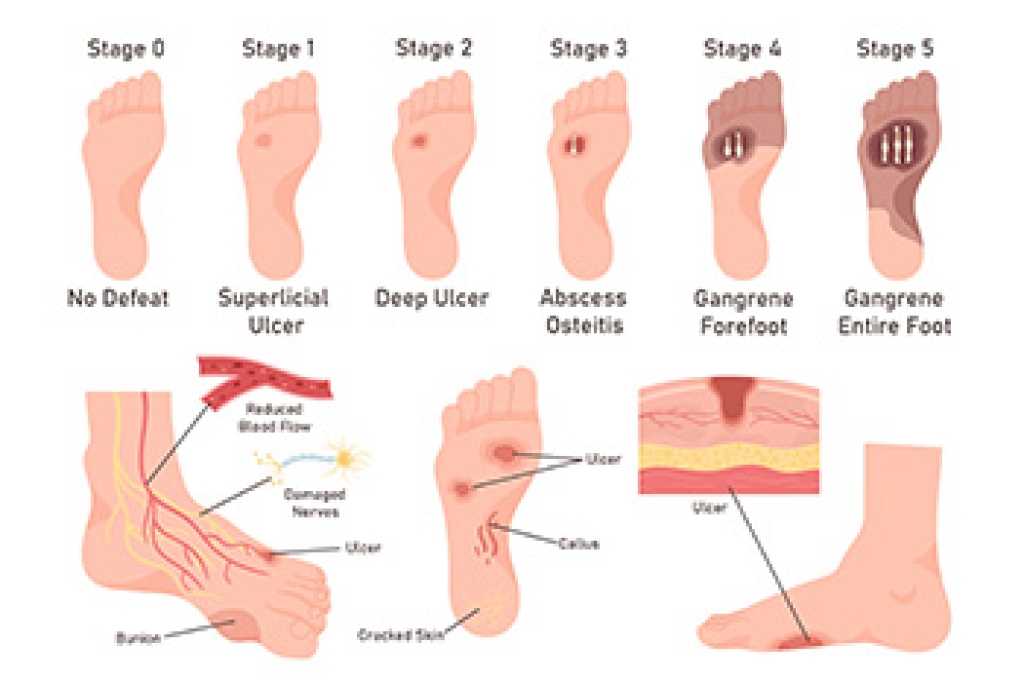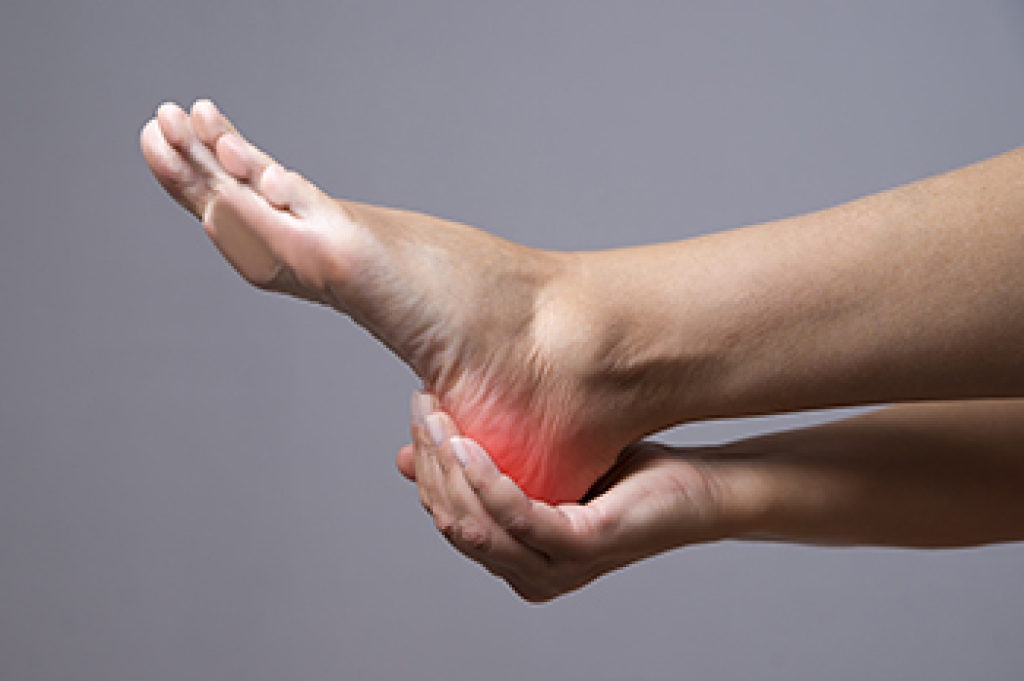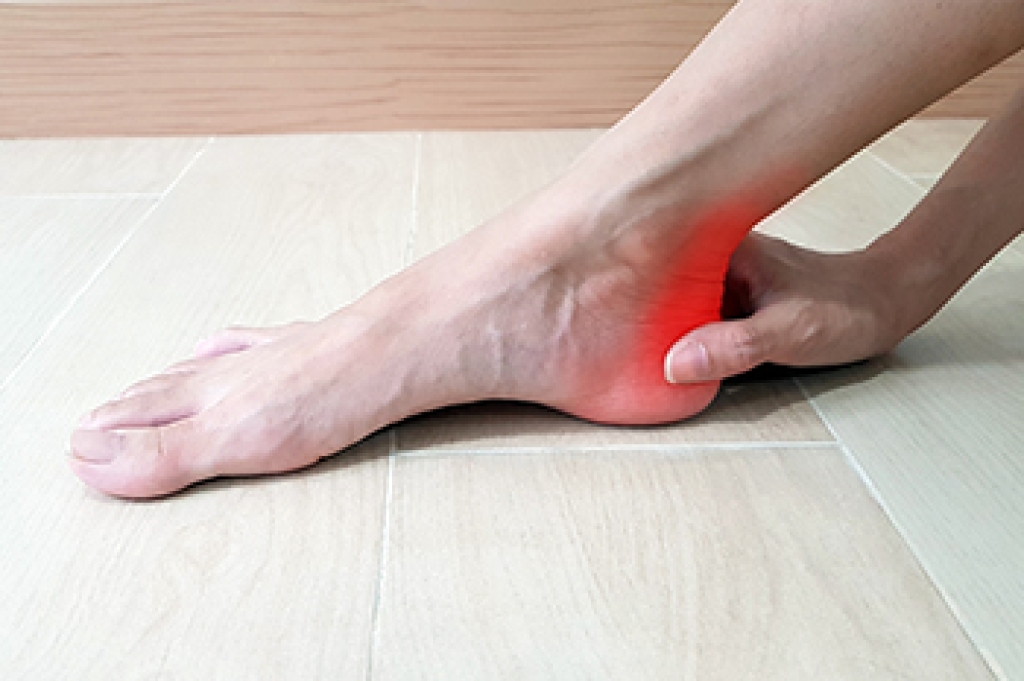Connect With Us
Blog
Blog
Stages of Diabetic Foot Ulcers

Diabetic foot ulcers are open sores or wounds that develop on the feet due to poor circulation and nerve damage caused by diabetes. They progress through several stages, beginning with normal healthy skin, followed by a high-risk stage where the skin becomes vulnerable. The ulcerated stage involves a visible sore, while the infection stage occurs when bacteria enter the wound. The necrotic stage is marked by dead tissue and severe damage. A podiatrist can help by cleaning and dressing the wound, improving circulation, prescribing medication, and creating a care plan to prevent further complications. If you have diabetes and notice any foot changes or sores, it is strongly suggested that you promptly schedule an appointment with a podiatrist who can help you to manage this serious condition.
Wound care is an important part in dealing with diabetes. If you have diabetes and a foot wound or would like more information about wound care for diabetics, consult with the foot specialists from Academy Foot and Ankle Specialists. Our doctors will assess your condition and provide you with quality foot and ankle treatment.
What Is Wound Care?
Wound care is the practice of taking proper care of a wound. This can range from the smallest to the largest of wounds. While everyone can benefit from proper wound care, it is much more important for diabetics. Diabetics often suffer from poor blood circulation which causes wounds to heal much slower than they would in a non-diabetic.
What Is the Importance of Wound Care?
While it may not seem apparent with small ulcers on the foot, for diabetics, any size ulcer can become infected. Diabetics often also suffer from neuropathy, or nerve loss. This means they might not even feel when they have an ulcer on their foot. If the wound becomes severely infected, amputation may be necessary. Therefore, it is of the upmost importance to properly care for any and all foot wounds.
How to Care for Wounds
The best way to care for foot wounds is to prevent them. For diabetics, this means daily inspections of the feet for any signs of abnormalities or ulcers. It is also recommended to see a podiatrist several times a year for a foot inspection. If you do have an ulcer, run the wound under water to clear dirt from the wound; then apply antibiotic ointment to the wound and cover with a bandage. Bandages should be changed daily and keeping pressure off the wound is smart. It is advised to see a podiatrist, who can keep an eye on it.
If you have any questions please contact our offices located in Southlake, Keller (Fort Worth), Hurst, North Richland Hills, Flower Mound, Argyle, and Denton, TX. . We offer the newest diagnostic and treatment technologies for all your foot and ankle needs.
Caring for Growing Feet

Children’s feet are constantly developing, and issues in the forefoot or midfoot can affect how they walk and play. Common concerns include flat feet, metatarsus adductus, or inward turning of the front of the foot, toe walking, or pain across the ball or arch of the foot. Sometimes these conditions resolve naturally as bones and muscles strengthen, but persistent pain or unusual gait patterns may signal a structural or alignment issue. A podiatrist can evaluate growth, check for joint flexibility, and recommend treatments such as custom orthotics, stretching, or footwear guidance to support healthy development. Early care helps prevent long-term problems and encourages confident, comfortable movement. If your child complains of foot pain, limps, or wears out shoes unevenly, it is suggested that you schedule an appointment with a podiatrist for a professional evaluation and personalized treatment plan.
The health of a child’s feet is vital to their overall well-being. If you have any questions regarding foot health, contact the foot specialists of Academy Foot and Ankle Specialists. Our doctors can provide the care you need to keep you pain-free and on your feet.
Tips for Keeping Children's Feet Healthy
- Make sure their shoes fit properly
- Look for any signs of in-toeing or out-toeing
- Check to see if they have Clubfoot (condition that affects your child’s foot and ankle, twisting the heel and toes inward) which is one of the most common nonmajor birth defects.
- Lightly cover your baby’s feet (Tight covers may keep your baby from moving their feet freely, and could prevent normal development)
- Allow your toddler to go shoeless (Shoes can be restricting for a young child’s foot)
- Cut toenails straight across to avoid ingrown toenails
- Keep your child’s foot clean and dry
- Cover cuts and scrapes. Wash any scratches with soap and water and cover them with a bandage until they’ve healed.
If you have any questions, please feel free to contact our offices located in Southlake, Keller (Fort Worth), Hurst, North Richland Hills, Flower Mound, Argyle, and Denton, TX. . We offer the newest diagnostic and treatment technologies for all your foot care needs.
Heel Pain and a Podiatrist’s Role in Relief

Heel pain occurs when the structures that support the foot become strained or irritated. It often develops from repeated stress on the heel, which can lead to inflammation and discomfort with daily activities. Middle aged adults, active individuals, people who are overweight, and those who stand for long periods of time are at higher risk because their heels experience greater pressure. Symptoms include sharp pain when taking the first steps in the morning, aching after activity, or tenderness along the bottom or back of the heel. A podiatrist can identify the cause, ease inflammation, improve foot alignment, and create a personalized treatment plan. If heel pain is affecting your mobility, it is suggested that you consult a podiatrist who can offer effective treatment solutions.
Many people suffer from bouts of heel pain. For more information, contact the foot specialists of Academy Foot and Ankle Specialists. Our doctors can provide the care you need to keep you pain-free and on your feet.
Causes of Heel Pain
Heel pain is often associated with plantar fasciitis. The plantar fascia is a band of tissues that extends along the bottom of the foot. A rip or tear in this ligament can cause inflammation of the tissue.
Achilles tendonitis is another cause of heel pain. Inflammation of the Achilles tendon will cause pain from fractures and muscle tearing. Lack of flexibility is also another symptom.
Heel spurs are another cause of pain. When the tissues of the plantar fascia undergo a great deal of stress, it can lead to ligament separation from the heel bone, causing heel spurs.
Why Might Heel Pain Occur?
- Wearing ill-fitting shoes
- Wearing non-supportive shoes
- Weight change
- Excessive running
Treatments
Heel pain should be treated as soon as possible for immediate results. Keeping your feet in a stress-free environment will help. If you suffer from Achilles tendonitis or plantar fasciitis, applying ice will reduce the swelling. Stretching before an exercise like running will help the muscles. Using all these tips will help make heel pain a condition of the past.
If you have any questions, please feel free to contact our offices located in Southlake, Keller (Fort Worth), Hurst, North Richland Hills, Flower Mound, Argyle, and Denton, TX. . We offer the newest diagnostic and treatment technologies for all your foot care needs.
Understanding Heel Pain and Achilles Tendonitis

Heel pain is a frequent concern, and one common cause is Achilles tendonitis. This condition is the inflammation of the Achilles tendon, which connects the calf muscles to the heel bone. Causes may include overuse, sudden increases in physical activity, or repetitive strain from sports. Risk factors include tight calf muscles, flat feet, or wearing shoes that lack adequate support. Symptoms often include stiffness, swelling, and pain that worsens with movement. A podiatrist can diagnose the Achilles tendonitis, provide treatment such as targeted stretching exercises or orthotics, and help prevent further injury. If you are struggling with heel pain or suspect you have Achilles tendonitis, it is suggested that you consult a podiatrist who can provide an accurate diagnosis and effective treatment solutions.
Achilles tendon injuries need immediate attention to avoid future complications. If you have any concerns, contact the foot specialists of Academy Foot and Ankle Specialists. Our doctors can provide the care you need to keep you pain-free and on your feet.
What Is the Achilles Tendon?
The Achilles tendon is a tendon that connects the lower leg muscles and calf to the heel of the foot. It is the strongest tendon in the human body and is essential for making movement possible. Because this tendon is such an integral part of the body, any injuries to it can create immense difficulties and should immediately be presented to a doctor.
What Are the Symptoms of an Achilles Tendon Injury?
There are various types of injuries that can affect the Achilles tendon. The two most common injuries are Achilles tendinitis and ruptures of the tendon.
Achilles Tendinitis Symptoms
- Inflammation
- Dull to severe pain
- Increased blood flow to the tendon
- Thickening of the tendon
Rupture Symptoms
- Extreme pain and swelling in the foot
- Total immobility
Treatment and Prevention
Achilles tendon injuries are diagnosed by a thorough physical evaluation, which can include an MRI. Treatment involves rest, physical therapy, and in some cases, surgery. However, various preventative measures can be taken to avoid these injuries, such as:
- Thorough stretching of the tendon before and after exercise
- Strengthening exercises like calf raises, squats, leg curls, leg extensions, leg raises, lunges, and leg presses
If you have any questions please feel free to contact our offices located in Southlake, Keller (Fort Worth), Hurst, North Richland Hills, Flower Mound, Argyle, and Denton, TX. . We offer the newest diagnostic tools and technology to treat your foot and ankle needs.
Blog Archives
- 2025
- 2024
- 2023
- 2022
- 2021

